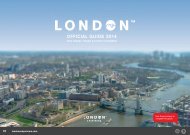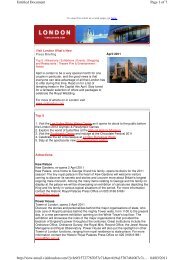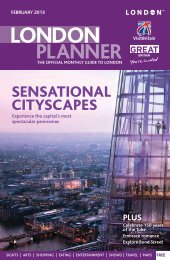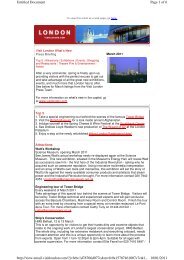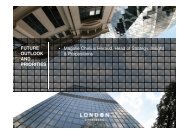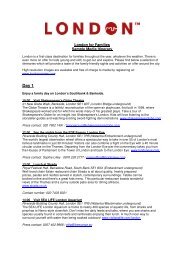London & Partners
London & Partners
London & Partners
Create successful ePaper yourself
Turn your PDF publications into a flip-book with our unique Google optimized e-Paper software.
LITERARY<br />
HAUNTS<br />
<strong>London</strong> is littered with illustrious<br />
literary locations that were once<br />
home to legendary poets, writers and<br />
novelists. Victorian author Charles<br />
Dickens lived and breathed the city,<br />
and his only surviving <strong>London</strong> home<br />
has been turned into a dedicated<br />
museum. The Charles Dickens<br />
Museum, recently reopened after<br />
refurbishment, holds the world’s<br />
most important collection of material<br />
relating to the author (Daily 10.00-<br />
17.00. Admission £8, child £6. 48<br />
Doughty Street, WC1. 020 7405<br />
2127. dickensmuseum.com<br />
Ë Chancery Lane. Map A6).<br />
Set amongst a maze of courtyards<br />
in the City of <strong>London</strong>, Dr Johnson’s<br />
House is the 18th-century abode<br />
of the writer of the famous English<br />
dictionary. Highlights of the carefully<br />
curated space include a stained glass<br />
portrait depicting his first major work<br />
of poetry, The Vanity Of Human<br />
Wishes (p. 56).<br />
Time stands still at Keats House<br />
where19th-century poet John Keats<br />
penned Ode To A Nightingale.<br />
Artefacts include precious and now<br />
fragile letters, books and notes, as<br />
well as trinkets to his beloved, girl<br />
next door, Fanny Brawne (Keats<br />
Grove, NW3. Fri-Sun 13.00-17.00.<br />
Admission £5, child free.<br />
020 7332 3868. cityoflondon.<br />
gov.uk/keatshousehampstead<br />
Ë Hampstead. Off map).<br />
Dickens Museum<br />
Dr. Johnson’s House<br />
Hampton Court Palace<br />
STEEPED IN HISTORY<br />
Hampton<br />
Court<br />
Palace (p. 28) is a<br />
fascinating remnant<br />
of the Tudor England<br />
that was Henry<br />
VIII’s stomping<br />
ground. Located<br />
on the outskirts<br />
of the capital, the<br />
historic palace<br />
retains the magnetic<br />
personality of the<br />
volatile monarch to<br />
this day. Have your<br />
imagination fired<br />
by the splendour of<br />
the interior: the Great Hall in particular, with its hammer-beamed roof and<br />
elaborate tapestry, brilliantly evokes the realities of a medieval banqueting<br />
hall. Then there’s the Chapel Royal, whose gilded ceiling has shone down<br />
upon centuries of monarchs in spiritual contemplation – it was here in<br />
1540 that Henry VIII recieved word from Archbishop Cranmer of the<br />
King’s young wife Catherine Howard’s unchaste behaviour before their<br />
marriage. Must-see spots in the grounds include the sympathetically<br />
restored Privy Garden, Lancelot ‘Capability’ Brown’s Great Vine, which still<br />
produces grapes after over 240 years, and the Hampton Court Palace<br />
Maze, which is great fun for kids.<br />
A more modest, yet no less stunning, example of Tudor architecture<br />
stands in the form of Sutton House in east <strong>London</strong>. The Grade-II listed<br />
former manor house, with its leaded windows and tranquil courtyard, is<br />
utterly evocative of the period. Original oak panelling, deep red tapestries<br />
and carved fireplaces complete the scene at the former home of Henry<br />
VIII’s courtier and privy counsellor, Sir Ralph Sadleir. Despite having had<br />
various tenants over the centuries, from merchants to Hugenot silkweavers<br />
and even squatters, not much has changed. Even the real sights, sounds<br />
and smells of the Tudor age come to life, care of the interactive displays in<br />
the house’s kitchen (2 Homerton High Street, E9. 020 8986 2264.<br />
nationaltrust.org.uk/sutton-house Ë Bethnal Green. Off map).<br />
January 2013|LONDON PLANNER|visitlondon.com | 17



